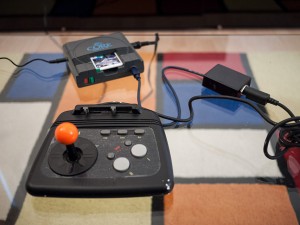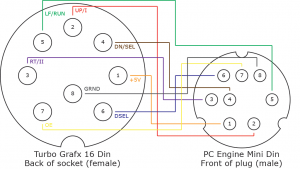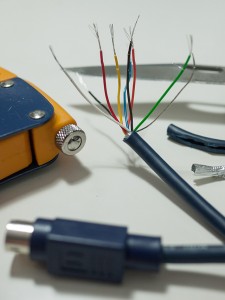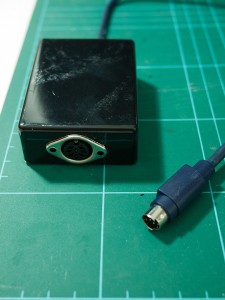Turbo Grafx to PC Engine controller adapter
One of the mysteries of video gaming is why manufacturers insist on taking perfectly good Japanese games consoles and redesigning them for the US and (less frequently) other markets. One particularly puzzling example is the NEC PC Engine. A small and sleek unit in Japan, it doubled in size for the US release and became the poorly spelt Turbo Grafx 16. As well as enlarging the console, NEC also saw fit to replace the mini-DIN plug used by the PC Engine controller with a full sized (though thankfully still standard) DIN. This meant and adapter was required to use PC Engine peripherals on the TG16 and vice-versa. However while the former was produced and is still available; the latter seems either never to have been manufactured or it was made in such small quantities that none are available today.
TG16 to PCE controller adapter; being used to connect a US Turbo Stick to a Core Grafx:

This proved annoyed as I’d just got hold of a TG16 Turbo Stick that I wanted to use with my various PC Engine consoles. Thankfully (and unlike Nintendo) NEC used standard 8 pin DIN connectors for its controllers. The function of the controllers was also identical between the two versions: the pins each handle two functions (e.g. D-pad up and the I button) which the console polls for separately. The DATA SELECT pin being used to select which set of buttons to poll (see emu-docs.org for a comprehensive explanation). This means that any adapter simply has to wire the corresponding pins in the two connectors to work.
Fig 1. Pin allocation for TG16 and PCE controllers:

As the adapter in this case would be from a TG16 controller to a PC Engine console it would need male mini-DIN plug and a female DIN socket. Figure 1 shows the pin numbering on each of the socket types. A spare MIDI cable provided the mini-DIN connection and after removing one end of it (figure 2), the adapter’s cable.
The cleanest way to house the DIN socket would have been with a proper wired socket end; thus creating a simple cable that sits between the console and the controller. Unfortunately I didn’t have one of these lying around and my local electronics store didn’t appear to sell them. However they did sell a simple 8 pin DIN socket and a small plastic enclosure.
Fig 2. Stripped end of an 8 core MIDI cable:

Eight soldered wires and a bit of drilling later and a fully functional TG16 to PCE controller connector was born. As figure 3 shows, it’s much larger than it needs to be; though I think this is fitting given the oversized nature of the TG16’s case. It could probably do with a couple of screws (or bolts) to help anchor the socket in the end of the case. But strong glue seems to be doing the trick for the time being.
